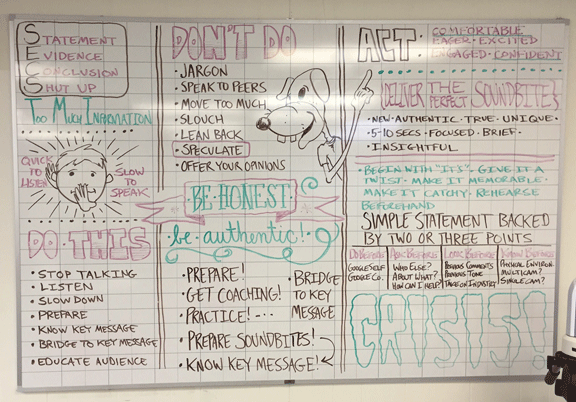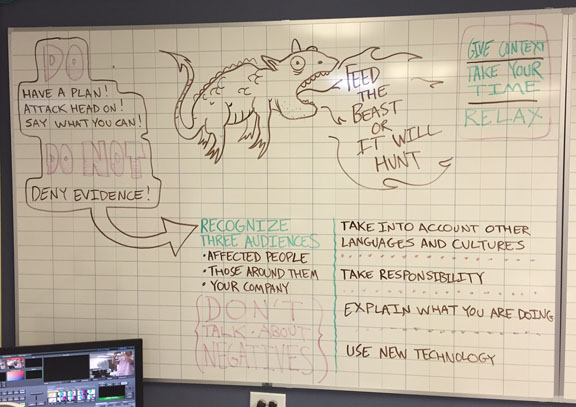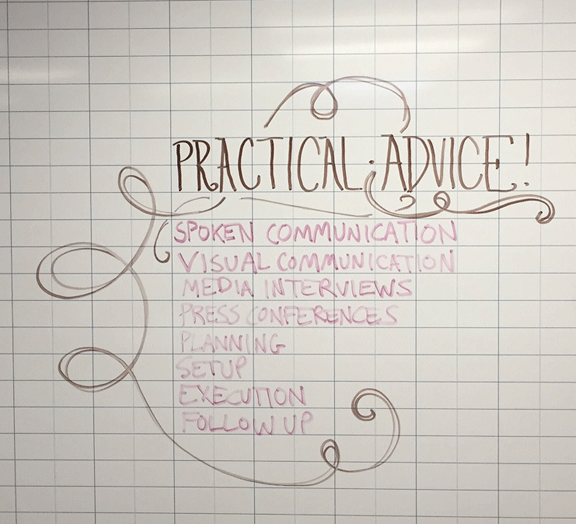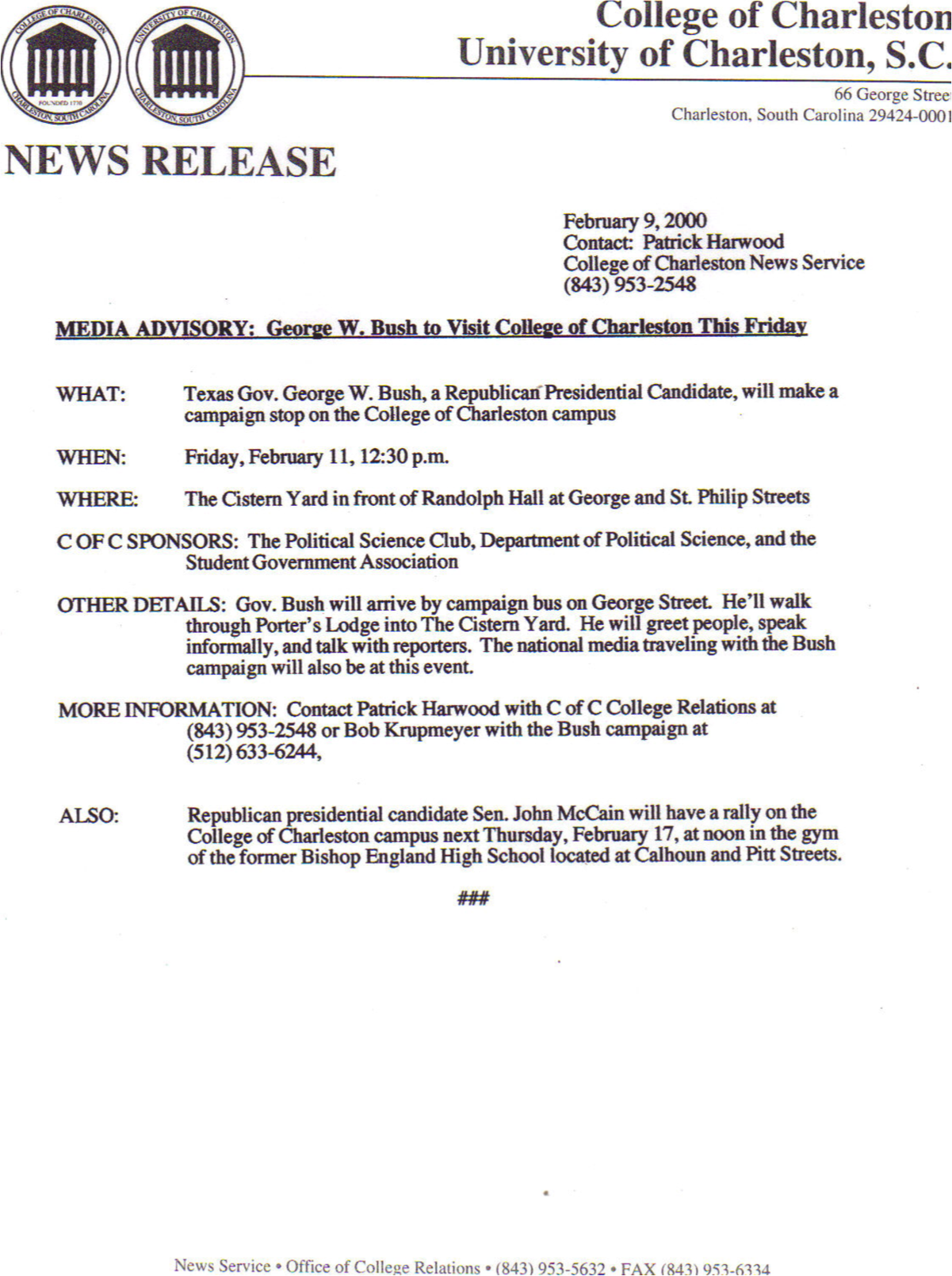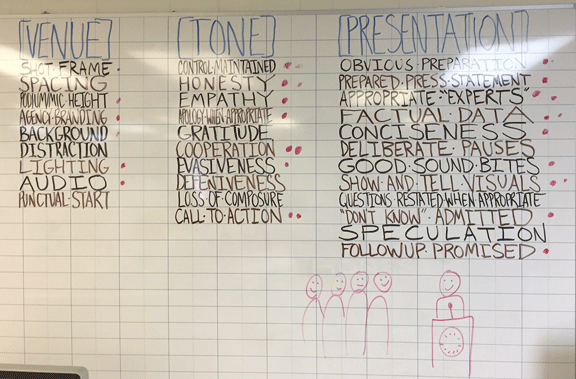OUTLINE (Bullet Points)
Objectives . . .
- verbal communication
- visual communication
- media interviews
- press conferences
- planning
- setting up
- execution
- follow-up
Why . . .
- has happened
- going to happen
- already happening
- needs to happen
- good or bad
Preparation . . .
- nervousness
- purpose
- elevator speech
- know your facts
- practice
- get acquainted
- set the direction
Execution . . .
- look at interviewer
- honest and concise
- deliberate pauses
- restate questions
- when you don’t know
- speculation
- posture
- body movement
- facial expressions
- control what YOU say
Follow up . . .
- contact information
- further inquiry
- follow-up
- media relationships
- press kit
9:55 Break
Similarities . . .
- target audience
- concise messages
- interaction with interviewer
- anticipated questions
- spoken/visual communication
Differences . . .
- individuals/organizations
- urgent/time sensitive issues
- wider audience
- physical setup
- multiple media representatives
- often covered “live”
- less control over questions
- a few sound bites
Planning . . .
- three major parts
- brainstorming, venue, handouts
- newsworthy
- 2-week lead time
- brainstorming session
- target audience
- desired tone of speech
- anticipated questions
- concise answers
- written press statement
- date and time
- venue considerations
- list of local media members
- written news release
- written press release
- press kit
- equipment set-up & testing
- placement of visuals
- punctual start
- gratitude
- media unable to attend
- evaluation of logistics
FULL NARRATIVE
~ Start
Today, we have several objectives all geared toward helping you be prepared to present yourself most effectively in front of the camera. Most of these have been listed as “Anticipated Outcomes” at the top of the SUMMARY you have been given. Our goal is to help strengthen your verbal and visual communication skills by providing practical advice in ways to handle media interviews and press conferences, including the necessary skills in planning, setting up, and the actual execution & follow-up associated with effective press conferences.
So, let’s begin with Media Interviews.
Most one on one media interviews take place because something has happened, is going to happen, has already happened, or needs to happen. That “something” can be something good or bad. In each of these cases, there is a message, a story, information and/or a call to action that needs to be shared with the public. As a representative of your organization or cause, it is your job to effectively communicate the message so the media is provided the material they need to accurately inform the public.
Everyone gets nervous to some degree when they speak in front of a camera. It’s natural. It is important to know that most interviewers do not purposefully seek to make you look bad. They are simply trying to help you communicate your message to a large audience. The best way to circumvent nervousness is to be prepared.
- Know the purpose of the interview –
- Why is this interview taking place?
- What is the media trying to accomplish with this interview? What are you trying to accomplish?
- Create/prepare an elevator speech –
- provides a short overview of your organization, your message, your goal, etc.
- can be delivered in the short time period of an elevator ride, usually 20-60 seconds.
- something you might already have on hand whenever anyone asks what you do.
- Know your facts!
- Prepare your facts on a sheet of paper that you can take with you if you need to reference them.
- It’s okay to have this with you. It is better to glance at your notes than give the public the wrong information.
- Practice your responses. Get to know them. Feel comfortable with them.
- Meet with the interviewer beforehand to get acquainted.
- This gives you an opportunity to ask “What are you hoping to get out of this interview” and set the direction for what you’d like to say as well.
- Taking the time to get acquainted with your interviewer, opens the door to a friendly, cooperative interview.
DURING the Interview
- Look at the interviewer. Looking directly at the camera makes you appear to be less engaged with the interviewer and less sincere. It makes you look bad.
- Honest and concise. Keep it short. The more concise you can be, the better. Many people think that giving a long detailed answer provides the public with the most information. That’s not necessarily true. News stories run (on average) 9 seconds to 2 minutes, at most. If you provide an answer that is 2 1/2 minutes long, the editor will pick the part that works best for them – and that might not be the part you want. Long rambling answers can also give the impression that you are not being completely honest, having to go on and on to justify something you have said.
- Sometimes, you can say a lot without saying anything at all. There is an enormous amount of power in the deliberate pause. It can be used in several ways-
- To add emphasis to a particular point.
- To amplify the feeling of your words, instead of just stating them.
- To convey sadness, anger, gladness…etc.
- To compose or “center” yourself
- To take a deep breath, and confidently launch into your opening words.
- To minimize utterances of “Um”
- To make it easy for editors to parse meaningful sound bites.
- Restate the question
- To rephrase a poorly stated question
- To give yourself extra time to think
- To ensure that your giving the correct answer
- To retake control of the direction of the interview
- It’s okay to admit when you don’t know the answer to a question. You should certainly never lie. Just politely admit that you do not know. If the answer can be obtained from someone else, you may offer to provide the answer at a later date.
- Do NOT speculate. Speculation only creates more story lines for the media – opening the door for many more follow-up questions. Don’t become the story as a result of statements you make that are based on speculation.
- Be aware of your posture, body movements and facial expressions. Be aware that how you stand, sit and move about during an interview often communicates more than the actual words you use. Close-up on your facial expressions can be particularly revealing. Knowing this can help you get your message across in the most effective way.
- In the end, you only have limited control over what the interviewer will ask you. You only have full control over what YOU say. So in that respect, the interview provides an EQUAL opportunity to say what you would like to say. The more prepared you are, the better your chances of emerging victorious even under the most adverse situation
AFTER the Interview
- Contact Info
- Give the viewers a way to learn more
- Provide contact info, a website, twitter, a hashtag, a facebook page, etc.
- Invite further inquiry. It would be a lost opportunity if you successful reached out to the community, but gave them no way to reach back.
- Promise a follow up (if necessary)
- This shows you’re willing to provide the community with answers
- It also shows a dedication to your message/organization/the public
- Cultivate media relationships
- Establish a list of local media contacts
- Create friendships with the media
- Create a press kit containing stories about the organization, issues, and people associated with it. If you are trying to promote a cause, yourself, or a nonprofit, this is a great way to show the reach of your message. Creating a media folder shows your relevance to donors, and may encourage increased donations.
————————————————–
~ after 30 minutes
Next, we are going to look at a 10-minute video produced by Beyond PIX Studio to help reinforce some of the tips we have presented thus far. Jason will handle this portion of our training.
————————————————–
————————————————–
~ after 55 minutes 5-minute BREAK
————————————————–
~ after 1 hour
Now, we are going to discuss some of the difference between media interviews and press conferences, including some of the very important steps in planning and handling effective press conferences.
Similarities – Like the media interviews we have been discussing, press conferences are aimed at a specific target audience. To be effective, we must plan concise messages and be prepared to interact with interviewers who will ask questions. We must plan responses to anticipated questions. Everything we have discussed about spoken and visual communication still applies.
Differences – Unlike media interviews which are usually requested by the media, press conferences are usually requested by individuals or organizations like yours. They are usually related to newsworthy urgent or time-sensitive issues of interest to a wider audience than ordinary media interviews. Your organization usually has complete control over the physical setup and multiple media representatives are invited to participate. Live coverage is often provided. During press conferences you usually have less control over the line of questioning. It is also very likely that the media will be reduce the entire press conference to a few sound bites, so the words that are spoken and the visual impression that is made become even more important.
Planning – There are three major parts in the planning of a press conference: Brainstorming, Venue, and Handouts.
Brainstorming
Before planning a press conference it is important to determine if the information is really newsworthy. If not, other ways to share your message should be considered. Do not establish a reputation for repeatedly attempting to gather media for press conferences that are not of interest to the news media.
Here are some cases when a press conference might be a good idea:
- A prominent individual to whom the media should have access is present
- You have significant announcements to make, such as a campaign start-up or a lobbying victory.
- When there is an emergency or crisis
- When a number of groups are participating in an action, and the show of support will emphasize that this action is news.
- When you want to react to a related event; for example, when a national report relevant to your issue is released
Once it has been determined that a press conference should be held, a 2-week lead time is recommended to properly plan. Planning should begin with a brainstorming session in which you decide what your message is going to be. If you do not have a public relations specialist, key staff and/or management should be involved in determining the key points to be addressed. In addition to the facts being considered, make sure to consider the target audience, the desired tone of the speech and how you might respond to anticipated questions with concise answers. If you aim to communicate with residents in a specific area of a town, then it is important to be familiar with the needs or interests of the residents in that area. If you are targeting other nonprofit organizations, then it would be helpful to know the basic goals of those organizations and their specific needs. A written press statement should be prepared during the brainstorming session presenting a concise statement regarding the issue at hand. This is the statement you will use when you introduce the press conference.
Venue
The date and time for the press conference as well as the location should be determined early on so invited media members will know where to go. Space, lighting and weather conditions (wind, rain, bright sun, etc.) are important venue considerations. Do you want a small, intimate setting, or do you need a larger room for more media? You should always have a contingency plan (alternate venue) if the original plan does not work for some reason.
Handouts
A crucial part of well-attended Press Conferences is having an organized list of local media members to contact. This list should be developed well beforehand. It may take a little research to compose this list, but it is the best way to develop professional relationships that will benefit you the most. Media can be invited through telephone calls if you have developed personal relationships, but written news releases should be distributed in any case. A news advisory is a one page summation describing where and when the press conference will take place, and what topics will be covered. Using the news advisory and your specific media contacts will help garner attention and generate higher turnout.
The written press release is a crucial handout for reporters in attendance because it provides all of the accurate necessary information to write the story later. Press releases should be formatted in AP Style (Associated Press) with your Contact Information clearly presented at the top. This should be the contact information for the most knowledgeable (and prepared) person regarding the subject in the organization – usually a Press Coordinator or member of management. The Headline should be highlighted in bold and the first line of the release should provide an accurate summary of the information followed by the Story. The Story should conclude with concise information about the services of the organization itself. The symbol “###” should be denoted at the end to designate the end of the story.
A press kit is a folder of information to give reporters background information about your issue or program. Your press kit should contain the following:
- A list of press conference participants.
- A press release
- Background information about the issue (i.e., statistics, historical background, case histories, or reprints of news stories).
- A few black & white glossy photographs (action photos are most interesting).
- Short (less than a page) biographies of participants.
- Related news stories from prestigious national publications (e.g., New York Times, Wall Street Journal, etc.).
The Press Conference
Be sure to allow sufficient time for equipment set-up & testing and placement of any visuals that will be used during the press conference. A punctual start is extremely critical because of the deadlines and rendering times required by reporters and editors to package their stories.
After the Press Conference, a final follow-up with media members is a good thing to consider. Expressing gratitude toward media members shows respect for the time they have taken to attend. Doing so also provides an opportunity to offer a full press kit. It will also cultivate a stronger working relationship for the future. Press releases should also be emailed to media who were unable to attend, so they have the information.
Evaluation of all logistics related to every Press Conference is the best way to ensure improved execution in the future.
Review of Sequential Steps . . .
- REASON for Press Conference determined
- BRAINSTORMING SESSION conducted
- TARGET AUDIENCE identified
- PRESENTER(S) identified
- ANSWERS to ANTICIPATED QUESTIONS prepared
- PRESS STATEMENT prepared
- VENUE, DATE & TIME determined
- NEWS ADVISORY prepared & distributed
- PRESS RELEASE prepared
- EQUIPMENT set up & tested
- VISUALS placed (branding, show & tell)
- PUNCTUAL START
- PRESS RELEASE distributed
- PRESS KIT distributed
- EVALUATION performed
————————————————–
Here is an another helpful checklist for Arranging a Press Conference created by Community Tool Box
___ You understand that a press conference is a tool designed to generate news — in particular, hard news that can advance the cause of your organization.
You understand the following reasons you might want to hold a press conference:
___ You can give more information than in a press release.
___ At a press conference, you can answer questions the press may have.
___ You can announce something unprecedented, which has significant local implications.
___ You can set the record straight if your group received negative publicity.
___ When many media representatives are present, it makes your conference seem really newsworthy.
___ A successful media conference can not only generate news, but can also boost the morale of your own group.
You understand that you might want to call a press conference in the following cases:
___ When the event includes a prominent individual to whom the media should have access.
___ When you have significant announcements to make, such as opening a campaign or reporting a lobbying victory.
___ When there is an emergency or crisis centered around your group or the issues it deals with.
___ When a number of groups are participating in an action, and the show of support will emphasize that this action is news.
___ When you want to react to a related event; for example, a national report relevant to your own issue is released.
Before the press conference, you have:
___ Started planning at least a week or two before the press conference is to take place.
Planning steps — you have:
___ Defined the issue and key messages that you and your group are trying to get out to the community.
___ Determined a date and time for the press conference, and made sure it doesn’t conflict with other press events or media deadlines.
___ Followed other tips for press conferences, such as scheduling the conference for a slower news day, scheduled your press conference is between 10:00 a.m. and 11:00 a.m.
___ Picked a location for the press conference that has adequate parking, is not too far away for reporters to travel, and provides visual interest and relationship to each topic.
___ Selected and trained participants who will be knowledgeable and articulate about the issue, who have high credibility, and, if possible, people from the community affected by the issue.
___ Found a moderator who is experienced with the press and the issue. He or she will be in charge of convening the press conference by introducing the issue and participants. The moderator also answers questions or directs them to the appropriate participants.
___ Attended at least one other press conference to get a feeling for what they are like.
___ Conducted a dress rehearsal.
___ Created a comprehensive mailing list of assignment editors at television stations, news directors at radio stations, and at major newspapers, and editors at weekly newspapers.
___ Had a press advisory prepared and mailed about one week ahead of time to inform the media about the press conference.
___ Followed up your press advisory after three days with phone contact to the major media outlets.
___ Followed up a second time the morning of the press conference.
___ Developed a press kit, if your group can afford it; or, if a press kit is beyond your budget, a press advisory.
___ Checked the location of electrical outlets for microphones and lights in the room where the press conference will be held.
___ Set up a table long enough to seat all your spokespeople, with name cards.
___ Provided enough seating in the room for reporters and their supporting equipment.
___ Displayed visuals as a backdrop to your speaker’s table: charts, posters, etc.
___ Set up a sign-in pad for attendance.
___ Provided a podium for the moderator.
___ Had coffee, tea, and water set up for the press conference.
Your press kit contains the following:
___ A list of press conference participants.
___ A press release, which should state your group’s position on the issue, highlights the press conference, and a few quotes from participants.
___ Background information about the issue.
___ A few black & white glossy photographs.
___ Short biographies of participants.
___ Related news stories from prestigious national publications.
At the press conference:
___ Welcome members of the press as they arrive.
___ Have members of the press sign in, with their affiliation, and give each of them a press kit.
___ Seat the press conference participants behind the table facing the seated reporters.
___ Check the sign in pad to see which media outlets are represented. You may also want to make personal contact with major media representatives before or after the press conference.
___ Start approximately on time–no later than 5 minutes after the scheduled time.
___ Tape record the event, for your own records, and for possible media use.
___ Have the moderator welcome the press, and introduce the issue and participants.
___ Each participant should present for no more than 3-5 minutes, making his/her 3-5 key points.
___ After all the presentations, the moderator should entertain any questions from the press, and direct questions to the appropriate participants.
___ After about 45 minutes, bring the formal conference to an end. Thank the participants for presenting, and the media for attending.
After the press conference:
___ You understand that not everyone may arrive, as your conference may be preempted by some late breaking news story elsewhere.
___ You may want to hand deliver a press release and press packet to these people, send a tape feed, or, try to schedule an interview with a reporter and one of the press conference participants.
*Source: Community Tool Box http://ctb.ku.edu/en/table-of-contents/participation/promoting-interest/press-conference/checklist
————————————————–
This attachment provides a summary of the main points of this workshop.
SUMMARY – Media Interviews and Press Conferences
~ after 90 minutes
Next, Jason will be presenting some clips from recent Press Conferences pertaining to the Water Crisis in Flint Michigan. He will guide you in recognizing and discussing some of the points we have been emphasizing all morning.
————————————————–
~ after 2 hours
Next, Emily will guide us through a practical exercise that will allow each of you to gain some valuable experience in planning and handling a simulated press conference.
————————————————–
TORNADO SIMULATION INSTRUCTIONS
- On a piece of paper, work as a team to write one statement summarizing the information gathered from all four departments. The statement should be approximately two-minutes in length.
- Before the press conference begins, decide if you want to invent any additional details beyond the facts listed above.
- The representative from the Mayor’s Office will deliver this two-minute statement to the press.
- After the statement, the floor will be open for questions. The Mayor’s Office may refer to the Police, Red Cross, or KEMA (Knoxville Emergency Management Agency) for answers.
- The public officials will answer questions from the press for 5-10 minutes.
- Members of the press must raise their hands and wait to be called on by an official.
- The press conference will conclude after no more than 10 minutes.
Note: When answering questions, be prepared to deal with questions you can’t answer, either because you do not think it wise to share the information or because you do not know the answer. Keep in mind that your ultimate goal is to satisfy public.
BACKGROUND – POLICE DEPARTMENT
- You do not yet have an official count of how many people have been injured or killed, but 911 calls have reported at least three fatalities.
- The downtown area is currently being evacuated due to the amount of debris and questions about building stability.
- South Knoxville Elementary School was in the direct path of the tornado.
- No one has yet been reported missing, but the entire area has not yet been searched.
- Many roads are impassable, making a full assessment of the damage impossible at this time.
- Some of the generators at the 911 call center are working, but callers may have difficulty getting through to an operator.
- You are currently asking media and those wishing to provide assistance to the affected areas to remain outside of the affected area until emergency responders and assessors declare this area safe.
- No information is available regarding the Tennessee football game currently scheduled for 10 days from now.
- 30 Additional police officers from surrounding areas have been called to Knox County for assistance.
- Encourage the public to report safe families and persons to Knox County Sheriff’s department to ensure that all are accounted for.
- Thus far, there have been 17 transports to the hospital, including the three fatalities.
BACKGROUND – RED CROSS
- Emergency Shelters have been set up at ______________ , _________________ , & ___________________________.
- More than 100 Red Cross volunteers are stationed at these shelters for assistance.
- 30 of these volunteers are registered nurses. However, you do not know how any nurses are at each shelter.
- At last report, there were 200 people utilizing the established shelters.
- Encourage the public to report safe families and persons to Knox County Sheriff’s department to ensure that all are accounted for.
- Heavy thunderstorms continue to move through the area and more tornadoes are possible.
- There is no current shortage of blood available.
- You want the people to know –
- They need to go to an underground shelter or safe room if available.
- A hallway on the lowest level of a sturdy building is also a safe alternative.
- Mobile homes are not safe during tornadoes. If you have access to a sturdy shelter or vehicle, get out of the mobile home immediately and go to the nearest sturdy building or shelter.
- If you can’t walk to a shelter quickly, immediately get into a vehicle, buckle your seat belt and try to drive to the closest sturdy shelter.
- If debris is flying while you are driving, pull over and park.
- You can stay in the car by putting the seat belt on, keeping your head down below the windows, and covering your head with your hands and a blanket if possible.
- If you can get safely to an area noticeably lower than the level of the roadway, get out of the car and lie in that area, covering your head with your hands.
BACKGROUND – Knoxville Emergency Management Association (KEMA)
- Power lines have fallen throughout the city and at least half of the city is without electricity.
- The mayor’s office is currently using back-up generators.
- More people will likely lose power as trees that were destabilized by the storm continue to fall.
- The main priority of the emergency response team is working to eliminate or reduce any immediate threats to human life.
- The area between __________&____________ has been designated as a high risk area
- The structure of at least one large building downtown was heavily damaged, leaving the building in danger of collapsing.
- The power grid in the downtown area between – _______ & _______ has been shut down until further notice.
- Do not assume that downed power lines are without power. Avoid unsafe, downed power lines until KUB staff can get to your area.
- Power to Community Television of Knoxville was unaffected.
- It is not yet known how long the power grid will be off.
BACKGROUND – MAYOR’S OFFICE
- A tornado touched down in Knoxville at approximately 9:40 am this morning.
- The tornado was very strong. It was rated F3 – “severe” – on a scale of F0 to F5.
- The tornado struck the heavily populated downtown area, breaking windows in hundreds of buildings.
- Heavy thunderstorms continue to move through the area. More tornadoes are possible.
- South Knoxville Elementary School was in the direct path of the tornado.
- Fortunately, the elementary school was evacuated 40 minutes before the tornado struck.
- The school is now uninhabitable.
- Schools will be closed tomorrow due to power outages.
- A current plan of action for the children that attended South Elementary School has not yet been determined.
- A curfew has been issued for 10 pm.
- No damage from the storm occurred in Oak Ridge or Maryville.
- Police, firefighters, emergency response teams, and over 300 volunteers working are currently attempting to secure the disaster area at this time.
QUESTIONS – PRESS CORPS
- Red Cross – Are people currently utilizing the shelters set up by Red Cross?
- Police – Has anyone been reported missing?
- Red Cross – Will people needing medical attention have access to healthcare professionals at the shelters?
- KEMA – Do you know how long the power grid will be shut down?
- KEMA – When did the city first know the tornado was going to touch down in Knoxville?**
- Police – Of the 14 transported to the hospital, are any of these injuries considered critical?**
- Mayor – How many fatalities are projected?
- Mayor – How long do you think South Knoxville Elementary will be closed?**
- Red Cross – Are displaced residents allowed to bring their pets to the shelters? If not, what should they do?**
- Mayor – Where will the displaced South Knoxville Elementary School students attend school in the meantime?**
- KEMA – When was the last time the tornado siren system was tested?**
- Police – If armed neighborhood volunteers want to volunteer to assist in preventing looting in heavily damaged areas, where should they report?**
- KEMA – When do you think your team will have a completed full assessment of the high risk area?
- Mayor – How is this tornado expected to affect the planned construction of the South Knoxville Waterfront?**
- Police – Do you feel you have enough police staff to cover this emergency?
- Mayor – We have heard reports of more tornadoes. Is it likely that Knoxville will be hit again?
- Red Cross – What should people be doing right now to prepare for another tornado?
** not answered in original background information
